In the realm of invasive species, Parthenium hysterophorus stands as a persistent enigma, captivating scientists and environmentalists alike with its astonishing ability to colonize diverse landscapes. Commonly known as “famine weed” or “ragweed,” this botanical intruder has earned its place as one of the world’s most noxious and damaging invasive plants. Its rapid proliferation disrupts ecosystems, agriculture, and human health, making it imperative to decipher the underlying causes behind its unchecked expansion.

Natural Adaptability: A Double-Edged Sword
Parthenium hysterophorus owes much of its success to its remarkable adaptability. Native to the Americas, the plant’s introduction to new regions was likely facilitated by human activities, such as global trade and travel. Its capability to thrive in diverse climates and soil conditions empowers it to establish strongholds even in unfavorable environments. Furthermore, its prodigious reproductive capacity, releasing thousands of seeds per plant, bestows a distinct competitive edge.

Soil Degradation and Disturbance
One of the pivotal factors driving the proliferation of Parthenium hysterophorus is its affinity for disturbed and degraded habitats. The plant’s colonization strategy capitalizes on anthropogenic disruptions, such as deforestation, urbanization, and agricultural expansion. These activities alter the landscape, creating open spaces where Parthenium can quickly establish a foothold. In doing so, the weed indirectly contributes to further habitat degradation by outcompeting native vegetation, which can lead to soil erosion, loss of biodiversity, and increased vulnerability to invasive species.

Allelopathy and Chemical Warfare
Parthenium hysterophorus employs a unique ecological warfare technique known as allelopathy. Through the release of allelochemicals, the plant inhibits the germination and growth of neighboring plants, affording it a competitive advantage in resource acquisition. This chemical interference can drastically alter the structure of ecosystems, giving Parthenium a higher chance of colonization success. Furthermore, this trait, along with its ability to accumulate high levels of toxic compounds, renders it unpalatable to herbivores, further exacerbating its unchecked growth.

Lack of Natural Predators
In its native habitat, Parthenium hysterophorus coexists with natural predators and pests that help keep its population in check. However, as it spreads to new regions, it often escapes the pressure exerted by these natural enemies. The absence of specialized herbivores and pathogens that can effectively control its growth in new environments contributes to its invasive success. As a result, the weed proliferates without the regulatory mechanisms that would otherwise maintain its population levels.
Human Factors and Cultural Practices
Human activities play an undeniable role in the spread of Parthenium hysterophorus. Unintentional introduction through contaminated seeds, soil, and agricultural products, as well as inadequate waste management practices, contribute to its dispersion across borders. Furthermore, ineffective land management and a lack of awareness about the plant’s invasive nature can lead to its unchecked growth. The absence of coordinated efforts to control its spread also allows the weed to persist and thrive.
Conclusion
The unchecked expansion of Parthenium hysterophorus is a multifaceted conundrum rooted in natural adaptability, human activities, and ecological disruption. Understanding the intricate web of factors that fuel its proliferation is crucial for devising effective strategies to mitigate its impact. Addressing this botanical invader’s success requires a multidisciplinary approach that combines ecological research, policy implementation, and public awareness campaigns. Only by unraveling the causes of Parthenium hysterophorus’ relentless conquest can we hope to curtail its devastating effects on ecosystems, agriculture, and human health.
Read More:- Top 5 Beauty Tips for a Luminous Face
Read More:- health tips in English for school assembly


